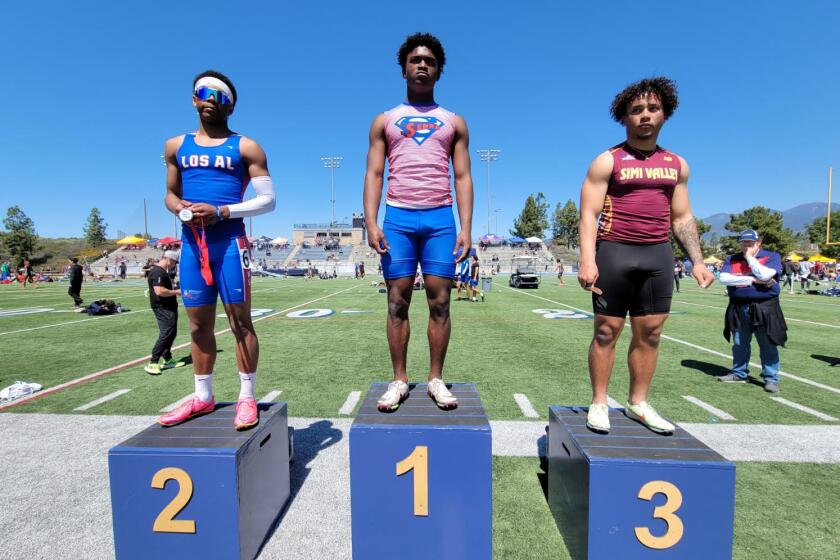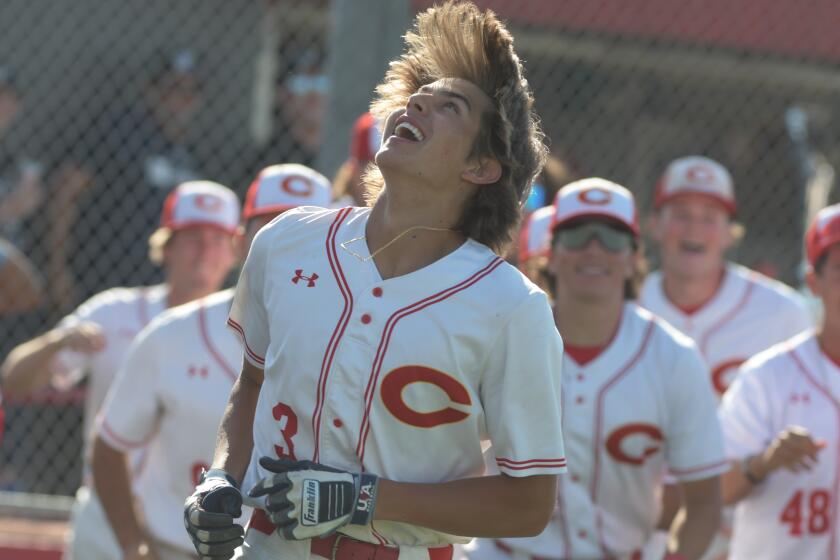Shooting for the Stars : Early Signing Puts Talent on the Spot, Names on the Line
A year ago at this time, Van Nuys High’s Anthony Cook was one of the most highly recruited high school basketball players in the Los Angeles area. The 6-8 senior forward who specialized in lob dunks that began in the rafters said that about 40 major colleges were on his trail. Coaches and recruiters were so persistent that daily life was becoming chaotic for Cook and his family.
So Cook chose to end the suspense. He signed with Arizona, taking advantage of a rule that permits high school seniors to pick a college in November rather than wait for the national-letter-of-intent day in April.
Today marks the start of a one-week period when this year’s seniors can sign. The ruling, adopted by the Collegiate Commissioner’s Assn. four years ago, allows signings until Nov. 20. The rule has received both praise and criticism. Cook is one who likes it.
“It took a lot of pressure off me,” he said Tuesday by telephone from Tucson, Ariz. “I was able to concentrate on basketball and my classes. I didn’t have to worry about coaches calling me up all the time. I had a big problem with coaches coming on campus (at Van Nuys). It was mind-boggling.”
The rule was created expressly to give relief to gifted players like Cook. It also was designed to help colleges cut costs and protect them from one another. Before the rule, if a player made an early verbal commitment to a college, that college would virtually have to play baby-sitter to him, protecting him from other persuasive schools trying to change his mind.
Some do not like the rule. They contend that once the drive to impress recruiters is removed, a player is more likely to lose his incentive to play well and that team concept becomes less important.
Two years ago, Richard Carr, a 6-7 forward at Thousand Oaks High, signed an early letter of intent to play at Stanford. In mid-season of his senior year, he quit the high school team. At that time his coach blamed the early signing rule.
Greg Herrick, former coach at Cleveland High and now an assistant at College of the Canyons, has always been critical of the rule.
“I think it was made strictly to help the colleges recruit under the (guise) of taking the pressure off the kids,” he said. “But what happens if a kid isn’t mature enough, he says, ‘What more do I have to prove?’ He’s not motivated (during his senior season) to improve himself or his team.”
Cook said he never became complacent or played tentatively to avoid injury after signing early.
“It never was that way with me,” he said. “After my junior year, when we lost in the quarterfinals (of the City 3-A playoffs), I really wanted to come back and win the championship. That was my goal. So I always kept my head in the game. I cared a lot about the team. When we lost (in last year’s semifinal), it hurt.”
Jeff Halpern coached Cook at Van Nuys last season. “It wouldn’t have made any difference if Anthony had waited until April to sign,” said Halpern, now at Birmingham High. “He was just as intense and he played just as hard. There was no change whatsoever in his attitude. He was the same before and after he signed.”
Top summer leagues that attract talented players have also become a target for critics of the rule. Some believe that emphasis is being shifted away from the high school basketball season and that recruiters are primarily interested in summer scouting. Much the same has been said about the players--that they reserve the dazzle for summer leagues and simply go through the motions during the regular season.
At least one member of the Collegiate Commissioner’s Assn., the governing body for the national letter of intent program, disagreed with that notion.
“I don’t buy that,” said Dutch Baughman, assistant to association chairman Fred Jacoby. “Summer leagues were around long before the early signing period.
“There haven’t been any problems outside of the normal ones associated with national letters of intent,” Baughman said. “The feedback we’ve received from both high school and college coaches--as well as the prospects and their parents--has been very positive.
“The early signing period has been accepted overwhelmingly. In fact, coaches in other sports have expressed interest in having the program for their sport.”
Although Cook had visited only two schools--Arizona and Loyola Marymount, he picked Arizona a year ago and became the only Valley player to take advantage of the early signing rule. Today, he’s one of three freshmen with a chance to become the backup forward for Coach Lute Olson’s varsity basketball team.
In his junior year at Van Nuys, Cook averaged 14 points and 10 rebounds a game, was the East Valley League’s most valuable player and made The Times’ all-Valley team. After signing with Arizona, Cook went on to exceed his junior-year accomplishments. He averaged 20.3 points and 13.8 rebounds, became league MVP again and earned another berth on the all-Valley team.
Although Cook had signed with Arizona, some of the colleges who lost the recruiting war weren’t ready to surrender. Cook still heard from coaches and recruiters.
“Some of them were real nice and seemed to care about me as a person,” he said. “They’d say things like, ‘If that’s where you really want to go, good luck.’ But some coaches would call and tell me I made the wrong decision. They did everything to try to make me change my mind.”
Cook believes that more high school players would sign early if they weren’t interested in free trips and a few extra months of being feted by college recruiters. Reportedly, only one Valley player, Trevor Wilson, is prepared to sign early during this year’s period. Wilson, a senior forward at Cleveland High, is said to be set to sign with UCLA.
“Some guys like to hold out until the second signing (in April) to get as much publicity as they can,” he said.
One reason Cook chose Arizona was because of Olson. Curiously, Olson might not have been around this season--he was offered the coaching job at Kentucky but turned it down. Had Olson left Arizona, Cook would still have been required to play with the Wildcats. In those situations, the NCAA takes the position that the player signed with the institution, not the coach.
“I love it here,” Cook said. “I’m not complaining. I made the right choice.”
Get our high school sports newsletter
Prep Rally is devoted to the SoCal high school sports experience, bringing you scores, stories and a behind-the-scenes look at what makes prep sports so popular.
You may occasionally receive promotional content from the Los Angeles Times.



